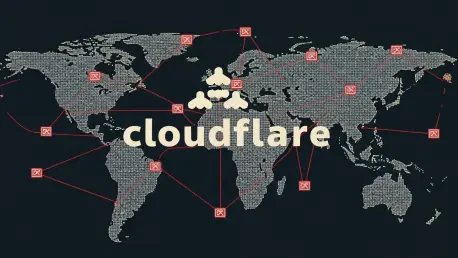Imagine a world where a single glitch can halt the operations of major airports, cripple essential public services, and render countless digital platforms inaccessible to millions of users across the globe, exposing the fragility of our digital ecosystem. This scenario became a stark reality when a significant outage struck a leading content delivery network and security provider based in San Francisco, causing widespread disruption to internet services. Valued at approximately $107.7 billion, this company underpins about 20% of the web, serving millions of customers, including a substantial portion of Fortune 500 companies. The incident, which unfolded just before 11:50 AM GMT on a Tuesday, sent shockwaves through various sectors. From transportation hubs to consumer apps, the ripple effects were felt universally, highlighting an urgent need to address the vulnerabilities in internet infrastructure. This event serves as a critical reminder of how interconnected and dependent modern systems have become on a handful of key players.
Widespread Impact Across Diverse Sectors
The scale of the disruption was staggering, as the outage affected an array of industries and services worldwide. Major Australian airport websites, including those of Melbourne, Brisbane, Perth, and Adelaide, experienced significant downtime, leaving travelers stranded without access to critical updates. Beyond transportation, digital giants like Uber, Shopify, Dropbox, and Coinbase faced operational hiccups, while even Moody’s credit ratings service reported interruptions. Public services weren’t spared either, with entities such as New Jersey Transit, New York City Emergency Management, and France’s national railway company SNCF grappling with slowdowns in their digital resources. The breadth of this impact underscores the pervasive role of internet infrastructure in daily life, where a single failure can disrupt everything from personal convenience to emergency response capabilities, painting a vivid picture of global reliance on stable connectivity.
Further amplifying the severity, consumer-facing platforms and creative tools also bore the brunt of the outage. Popular services like OpenAI’s ChatGPT, dating app Grindr, gaming platform League of Legends, and design tool Canva encountered errors, frustrating users who depend on these applications for work, leisure, and social interaction. Even cloud computing services from major providers experienced cascading effects, reminiscent of a similar incident involving Amazon Web Services in October of a prior year. This broad spectrum of affected entities illustrates how deeply embedded internet services are in both professional and personal spheres. The outage didn’t just interrupt routine tasks; it halted productivity and communication for countless individuals and organizations, raising critical questions about the robustness of systems that billions rely upon every day for seamless operation.
Critical Role and Vulnerability of Internet Infrastructure
At the heart of this disruption lies the pivotal role of the affected content delivery network, which acts as an intermediary to enhance website speed and security for millions of users. When such a service falters, the consequences are profound due to its extensive reach across the digital landscape. Cybersecurity expert Professor Mike Chapple emphasized that the intermediary function, while designed to optimize performance, becomes a single point of failure during outages, leading to widespread 500 errors and inaccessible dashboards or APIs. This incident, which saw a fix deployed around 1:45 AM Wednesday after hours of chaos, revealed that even swift responses couldn’t immediately eliminate intermittent issues. The complexity of restoring full functionality across a vast network highlights a significant challenge in maintaining uninterrupted service for a globally connected audience.
Delving deeper into the implications, this event exposed the inherent fragility of modern internet-dependent systems. The outage not only disrupted consumer apps but also critical public services, demonstrating how interconnected digital ecosystems are and how a breakdown in one area can trigger a domino effect. While the problem was identified and addressed relatively quickly, lingering errors for hours afterward pointed to the intricate nature of managing such expansive infrastructure. This scenario draws parallels to other recent disruptions in cloud-based systems, suggesting a troubling pattern of vulnerability. As more services migrate to centralized platforms, the potential for massive digital gridlock grows, urging stakeholders to rethink strategies for building resilience and redundancy into the backbone of the internet to prevent future catastrophes of this magnitude.
Lessons Learned and Path Forward
Reflecting on the aftermath, the incident served as a wake-up call for industries and policymakers who witnessed firsthand the cascading effects of a compromised internet service. The disruption, which left millions unable to access vital platforms, underscored the urgent need for diversified infrastructure to mitigate risks associated with centralized dependencies. It became evident that while rapid fixes were implemented, the persistence of intermittent issues signaled gaps in recovery protocols that needed addressing. This event pushed conversations around digital resilience to the forefront, encouraging a reevaluation of how critical services are safeguarded against unexpected failures in the systems that support them.
Moving forward, the focus shifted to actionable steps that could prevent such widespread outages from recurring. Industry leaders began advocating for enhanced redundancy measures and decentralized approaches to content delivery and security services. Collaborative efforts between technology providers and public sectors emerged as a priority to ensure that essential services remain operational during crises. Additionally, investments in robust backup systems and improved monitoring tools were deemed essential to detect and resolve issues before they escalate. This disruption ultimately paved the way for a broader dialogue on fortifying global internet infrastructure, ensuring that the lessons from this incident would guide future innovations and policies to protect against digital vulnerabilities.









